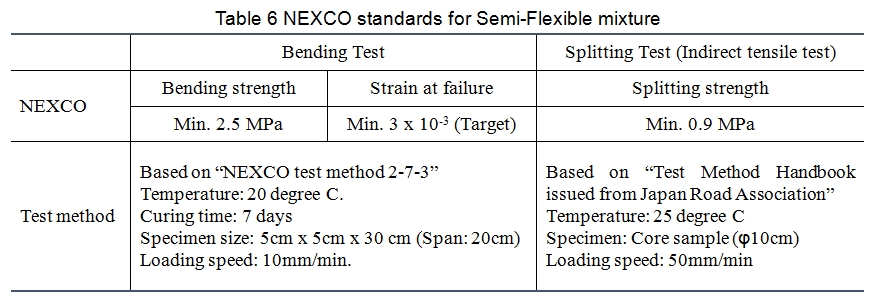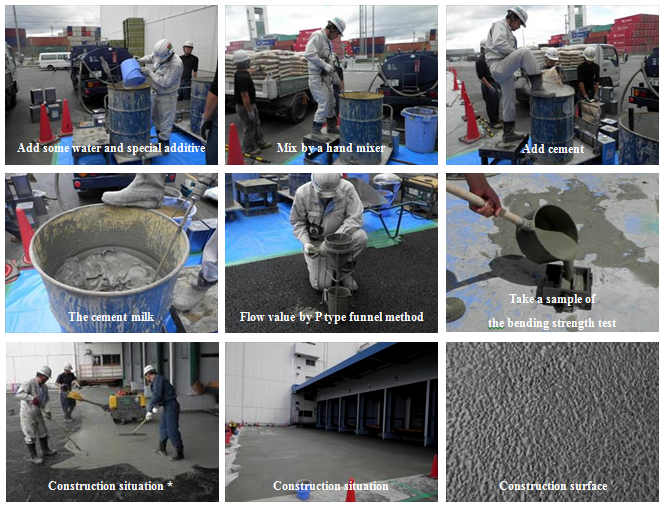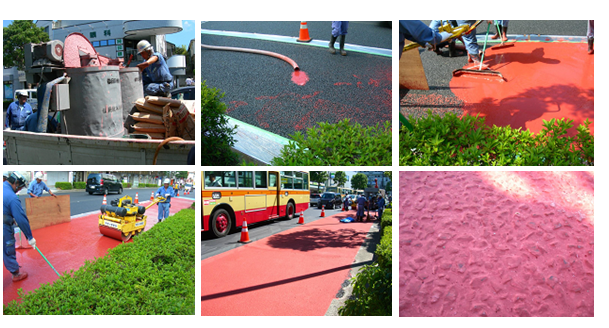SEMI-FLEXIBLE PAVEMENT
Cement Milk Modifier for
SEMI-FLEXIBLE PAVEMENT
STP (Strong Pave)
ABOUT SEMI-FLEXIBLE PAVEMENT.
Semi-flexible pavement is a pavement combining both of flexibility and rigidity, which asphalt pavement and cement concrete pavement have respectively. The characteristics of the semi-flexible pavement are brought by filling the air voids of more than 20% of the asphalt pavement by special cement milk. That cement milk can enhance stiffness, load bearing ability, oil resistance, and heat resistance of the asphalt pavement. And, the characteristics of the semi-flexible pavement are as follows;
- The semi-flexible pavement can enhance the resistance to plastic deformation.
- The semi-flexible pavement can enhance the oil-resistance and the heat-resistance.
- By coloration of the cement milk, asphalt pavement can be easily changed into color pavement.
The semi-flexible pavement has been constructed at the various places, like bus stops, tollgates of the expressway, and the site of factory in Japan. Furthermore, if using colored cement milk in which color pigment is employed, it would be able to be colored pavement, it would be used for various pavement scene.

ABOUT MATERIALS STANDARDS USED FOR SEMI-FLEXIBLE PAVEMENT.
≪Open-Graded Asphalt Mixture≫
The matrix of the semi-flexible pavement is constituted by open-graded asphalt mixture. The properties of the open-graded asphalt mixture are as follows;
Table 1 Gradation of asphalt mixture for the semi-flexible pavement

Normally, straight asphalt 60/80 is employed for the Open-graded asphalt mixture for the semi-flexible pavement. If the open-graded asphalt mixture would be opened for general traffic before cement milk would be permeated, however, using modified asphalt or TPS would be recommended.
≪Cement Milk≫
The role of the cement milk used for the semi-flexibility pavement is very important. In comparison with conventional cement milk, it is preferable to be improved in terms of shrinkage resistance, cracking resistance, adhesive property coloring, and others.
We have some kinds of cement milk so as to meet the paving site conditions, Ordinary type, arly-Strength type, Rapid Hardening type, and Ultra-Rapid Hardening type. These depend upon the characteristics of cement used.

Note) *) In case of using Shore Hardness Tester, the value of more than 60 can be regarded as same as the compressive strength of more than 4.9 MPa. Therefore, if the Shore Hardness Tester would provide more than 60, the semi-flexible pavement would be able to be opened to general traffic.
**) The dimension of the specimen for bending test shall be 4ccm x 4cm x 16cm, span length of 12cm. Regarding the test conditions, curing temperature is 20±3 degree C.


The cement milk is injected into the air voids of open-graded asphalt mixture. The amount used of the cement milk is calculated as follows;

Note) By using a specimen for wheel tracking test, which dimension is 5cm x 30cm x 30cm, the amount of cement milk injected needs to be checked in advance. And this data should be a base data for performance control for semi-flexible pavement.
≪Semi-Flexible mixture≫
Regarding the quality of semi-flexible pavement consisting of open-graded asphalt mixture and cement milk, NEXCO has set the specification about bending strength and strain at failure. However, when there isn’t a bending test apparatus, Splitting Test (indirect tensile test) is available instead of bending test. The standards are as follows;

ABOUT PAVING POROUS ASPHALT MIXTURE AS A MATRIX

≪Laying matrix of the semi-flexible pavement≫
At first, the porous asphalt mixture as a matrix is paved. The air void percentage is 20% to 28%. If the air void percentage is smaller, it is becoming difficult to inject cement milk. 23% to 25% would be recommended. The control of the air void percentage should be due to the mix proportion of the porous asphalt, not due to compaction. Regarding paving method, it is same as conventional one.
The porous asphalt pavement which has been finished paving should be cared till the temperature would become normal. Otherwise, it is becoming difficult to inject cement milk.≪Curing the porous asphalt which has been paved≫
ABOUT PRODUCTION OF CEMENT MILK WITH “STP”.
STP is delivered in the package of 26.5kg or 28.5kg in the case of Vietnam. One bag of STP is used for one bag of cement which is 50kg. And, water is 40% of the total weight of cement and STP.

Note) The unit weight of cement milk is assumed to be 1.85g/cc.
(1) Using a grout mixer is recommended to mix the cement milk. If there is not a grout mixer, drum of about 200 litters’ capacity is available, but in this case, we need to select a suitable mixer.
(2) Materials needed for the cement milk are STP, cement, and water. The amount of each material for 1 batch depends upon the capacity of the grout mixer.
(3) Tap-water or equivalent to this are recommended as water for cement milk. If dirty water would be used, the reaction of cement might be disturbed.
(4) The materials shall be put into a mixer in the order of water, cement, and STP.
(5) The standard mixing time shall be 3 minutes after adding STP so that the powder modifiers can be dispersed and the cement milk can be uniform.
(6) After mixing, the viscosity of the cement milk shall be measured using P type funnel. P funnel value of 10 to 12 second is preferable. If preferable consistency cannot be obtained by the influence of temperature, adjustment by small quantity of water is allowable.
(7) In case of hot temperature, because the viscosity might be getting higher in short time, please take attention to the viscosity of the cement milk.

* The cement milk is infiltrated to the open-graded asphalt mixtures by the vibration of the vibrating roller.
ABOUT QUALITY TEST OF CEMENT MILK WITH “STP”.
The cement milk should be carried out the quality test at each construction site. The test results in the case of using Vietnamese cement are as follows;

Note) The cement which was used for this test is PCB40 made in Vietnam.
The curing temperature for compressive strength test is 20 °C.
ABOUT INJECTION OF CEMENT MILK WITH “STP”.
In general, the cement milk is injected by naturally flowing down, the special machines are not employed. However, a vibration roller shall be available to fill the air void of the matrix, the porous asphalt mixture, by cement milk. It is very important that we need to pay attention to the viscosity control of cement milk, flow value by P type funnel method.
After the cement milk has been injected, the residual excess cement milk should be scraped off by a rake or other tools till the aggregate surface would appear. Otherwise, the surface might be getting slippy because the cement milk surface would be polished with by the tires of vehicles.

DURABILITY OF SEMI-FLEXBLE PAVEMENT
Semi-flexible pavement paved on a heavy duty road 26 years ago. Although there are some cracking, there are no rutting. There are no problem with safety driving even after 26 years.

COLORED SEMI-FLEXIBLE PAVEMENT.

